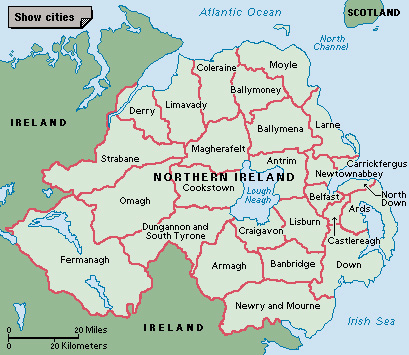Dungannon is a historic market town in the south-central part of Northern Ireland. It lies in an area of rolling hills about 8 miles (13 kilometers) west of Lough Neagh (Lake Neagh). In Irish, Dungannon’s name is Dún Geanainn (Fort of Geanann). Geanann was one of the historic árd rí (high kings) of Ireland. Dungannon is in the Mid Ulster local government district. It is home to many of the district’s administrative offices.
Farming has traditionally been the main industry in the Dungannon area, and both beef and dairy cattle are important to the economy. Crops include barley and potatoes. Sand is quarried in the area. Other local products include bricks, glassware, and synthetic fibers.
Castle Hill, also called the Hill of the O’Neill, rises in the center of Dungannon. Many historians think a stone fort existed there by the 500’s. The powerful O’Neill clan built fortifications there in the 1200’s, and the site came to include a tower house, a kind of castle. The O’Neills ruled an area known as Tír Eoghain (the land of Eoghain) from Dungannon for hundreds of years. In the early 1600’s, Hugh O’Neill set fire to the tower house before English forces arrived to occupy the area. See Tyrone, County (History).
About 1610, Dungannon came under the control of Sir Arthur Chichester, an English soldier and administrator. Chichester rebuilt the castle and established a community at Dungannon for British Protestant settlers. The businessman Thomas Knox-Hannyngton built a grand house on Castle Hill in the late 1700’s. The house was abandoned in the mid-1800’s. However, two towers from the ruined structure remain at the site.
Dungannon is in County Tyrone, one Northern Ireland’s six historic counties. County Tyrone ceased to be used as an administrative area In 1973, when local government was reorganized. Dungannon became the name of a district council area—a kind of local government district—centered on the town of Dungannon. In 1999, the district’s name was changed to Dungannon and South Tyrone. In 2015, most of the Dungannon and South Tyrone district was combined with the Cookstown and Magherafelt districts. Together, these areas formed the new Mid Ulster district. A small area in the northeast corner of Dungannon and South Tyrone became part of the Armagh City, Banbridge and Craigavon district.

